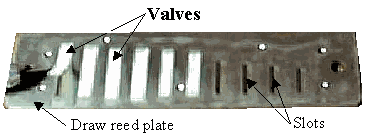

On harmonicas, "valves" are flaps attached to the reed plate at the rivet over the slot opposite the reed. See the picture above. They are made out of a thin plastic strip, or pair of strips, though they used to be made of other materials such as leather.
Valves are most often found on chromatic harmonicas, on which they are usually called windsavers. They do indeed function as valves, blocking the air stream during a draw from entering through the blow reeds (and vice versa for draw reeds) while allowing the air stream during a blow to exit via the blow-reed slot (again vice versa for draw reeds). And since they block the air stream from the opposite reed, less air is required overall to play a reed--thus they save wind, which is important on most chromatics because their mouthpieces and slide assemblies typically leak substantial amounts of air. Windsavers on chromatic are normally present for every reed, sometimes with the exception of the very highest notes.
Such is not the case on diatonics, which are generally much more air tight than their chromatic cousins. The valves on diatonics are not used as windsavers. They are used to facilitate valved bends.
A valved-bend is simply a bend on a reed whose paired-reed (i.e. in the same chamber) is valved. On the diatonic, not all reeds are valved. The valves are used to obtain bends not normally available on the diatonic harp. Normal bends are draw bends on holes 1 through 6, and blow bends on holes 7 through 10. A valved diatonic allows all the regular bends, plus blow bends on holds 1 through 6, and draw bends on holes 7 through 10. So, when valving a diatonic harp, the flaps are placed as follows:
Installation is simply a matter of using super glue to attach the plastic
flaps to the reed plate at the rivet point on the other side of
the plate from where the reed is attached. Only a tiny amount
of super glue should be applied to the valve, and care must be taken not
to get glue on the reeds! The super glue should be put on a small
slip of paper or plastic, and the end of flap should be dipped into the
glue in order to control the amount of glue applied. If you try to
squeeze the glue out of a tube onto the reed plate, you're sure to get
too much and have problems!
You can buy valves from Hohner, Bill Romel, John Infande, and probably other harp customizers, or you can make your own. In some sense, valves have not been perfected, and they frequently can rattle or buzz. One of the best materials to use for valving is a thin (0.003) mylar covered with 3M Micropore tape. The tape side goes down, toward the plate, which helps reduce sticking, popping, buzzing, etc. The valves should be trimmed to just barely cover the slot they're on top of.
Take care when reassembling the harmonica that the comb does not interfere with the free operation of the valves. If the comb keeps the valve from lifting during play, the reed won't sound, or won't sound right.
Valved bends are a little different than normal diatonic bends. During a normal bend, both reeds in the chamber can participate to produce the characteristic gutsy sound. These dual-reed bends tend to "snap" into place at the lowest note available. Valved bends are more delicate and require more control to execute cleanly and clearly on pitch. Only one reed participates in the generation of the sound, since the other reed is blocked by the valve. It is especially important not to attack the bend hard when you initiate it, otherwise it will choke off and not sound. It is also very important to bend "from your diaphragm" for valved bends. A pinching of the lips will not produce a good valved bend. Valved bends can be done on the chromatic, as well as a valved diatonic.
The only commercially available valved diatonic at this time is the
valved Suzuki ProMaster (or the semi-chromatic Hohner Slide Harp). But,
with a little practice valving your own harp will only take 5 or 10 minutes.
![]()
Valves interfere with overbends. For example, if a draw reed has been valved, an overblow is not possible in that chamber because the airflow cannot reach the draw reed during a blow. The bottom line is that you can't play valved bends and overbends in the same chamber.
Valving the draw reeds in holes 1, 2, 3, and the blow reed in hole 8, is the optimal way to valve a harp while still allowing full chromatic play without losing the most useful overblows.